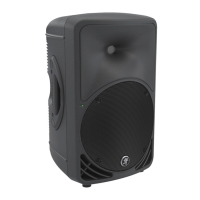
Do you have a question about the Mackie SRM350 and is the answer not in the manual?
| Max SPL | 121dB |
|---|---|
| Crossover Frequency | 3 kHz |
| Input Connectors | XLR, 1/4" TRS |
| Enclosure Material | Polypropylene |
| Outputs | 1 x XLR (mix out) |
| Woofer Size | 10 inch |
| Tweeter Size | 1.4 inches |
| Type | Active |
| Inputs | 2 x XLR-1/4" combo, 1 x stereo RCA |
Details FCC and Canadian compliance for digital devices and RF energy.
Guidelines on safe noise exposure levels and permanent hearing loss prevention.
Advice on protecting the apparatus from moisture and proper disposal.
Details the 10-inch woofer and 1.4-inch titanium compression driver.
Explains the Class-D and Fast Recovery amplifiers, power ratings, and limiter.
Describes the 24 dB/octave Linkwitz-Riley electronic crossover design.
Discusses the robust molded composite cabinet and asymmetrical trapezoidal design.
Step-by-step guide for connecting and powering on the SRM350v2 for the first time.
Covers the IEC socket, POWER switch, and POWER indicator LED.
Details the CONTOUR, LEVEL, MIC/LINE switch, and SIGNAL/LIMIT indicators.
Explains the INPUT (XLR/TRS) and THRU (XLR) connectors for audio signals.
Details balanced/unbalanced XLR and TRS input wiring standards.
Explains using the THRU jack to connect multiple SRM350v2 speakers.
Tips for optimal speaker positioning in various room types and for audience coverage.
Instructions for using optional hanging brackets and important safety warnings.
Ensures proper convection cooling by maintaining adequate space behind the unit.
Advice on using the LEVEL control to avoid overheating the amplifiers.
Details voltage requirements, current draw, and the need for a robust AC supply.
Recommends separating audio and lighting power for noise reduction.
Specifies maximum SRM350v2 units per 15A circuit and safe power-on/off sequencing.
Emphasizes using outlet testers and never removing the power cord's ground pin.
Guides users through diagnosing and resolving power, sound, and level problems.
Offers solutions for identifying and eliminating unwanted noise and hum.
Strategies for dealing with external noise sources and ground loop issues.
Recommendations for wiring, grounding, and component placement to reduce noise.
Details how to obtain warranty service and locate authorized service centers.
Advice on cleaning the cabinets and protecting the speakers from environmental factors.
Technical data including frequency response, SPL, input types, and impedance.
Power amplifier ratings, transducer dimensions, sensitivity, and frequency ranges.
Dimensions, weight, and mounting methods like pole-mounting and rigging.